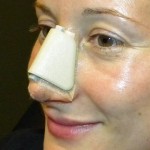
It is well acknowledged that the best way to avoid the need for revisional surgery is to prevent or avoid the type of problems that lead to it. From that perspective, what are the most common primary rhinoplasty problems? In the October 2013 issue of Plastic and Reconstructive Surgery these issues are addressed in an article entitled ‘Frequency of the Preoperative Flaws and Commonly Required Manuevers to Correct Them: A Guide to Reducing the Revision Rhinoplasty Rate’. In reviewing 100 secondary rhinoplasty patients, the most common reason for surgery was functional in nature with airway obstruction and septal performation. Aesthetic reasons were largely for asymmetries of the bridge, nostrils and tip. Accordingly, the most common secondary rhinoplasty procedure was septoplasty to either improve a breathing issue or to harvest cartilage grafts to address the aesthetic asymmetry issues.
While some may view secondary rhinoplasty patients as difficult and hard to please, the vast majority have legitimate concerns that can be improved with good results as this and other studies have shown. Given that breathing problems are such a common complaint, a variety of preventative manuevers during the initial rhinoplasty can be done. As stated in the article these include the use of spreader grafts, high-to-low nasal osteotomies and partial reduction of the inferior turbinates. The prevention or treatment of common aesthetic deformities can be done with the aggressive use of of dorsal, lateral crural struts and alar rim grafts for prevention of distorting forces during healing and to camouflage structural irregularities.
One of the most basic tenets of contemporary rhinoplasty is to avoid reductive/destructive manuevers and focus more on reshaping the natural cartilage with sutures and the liberal use of cartilage grafts for support. This creates stronger noses that can better resist the inward forces of inspiration and protect against scar contracture afterwards.
Dr. Barry Eppley
Indianapolis, Indiana


